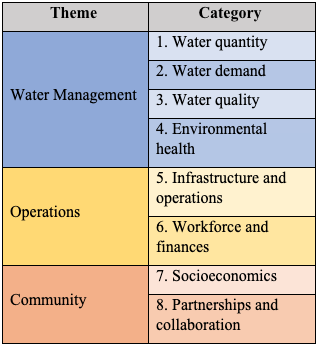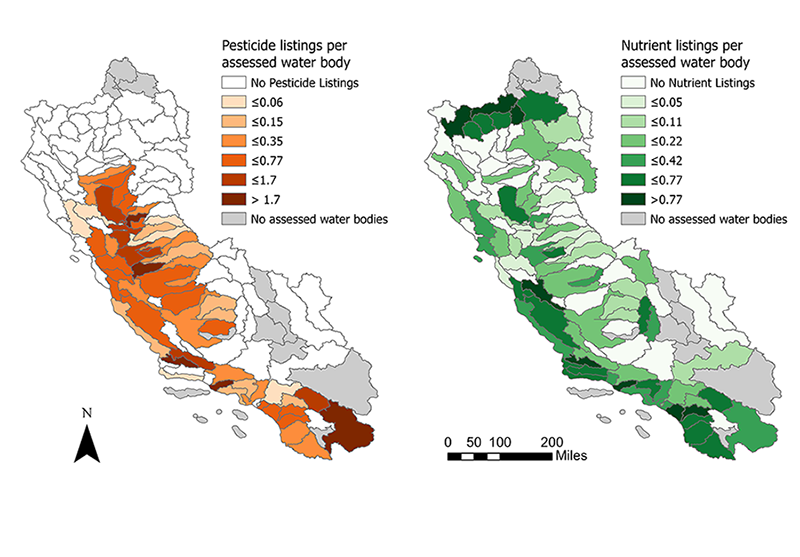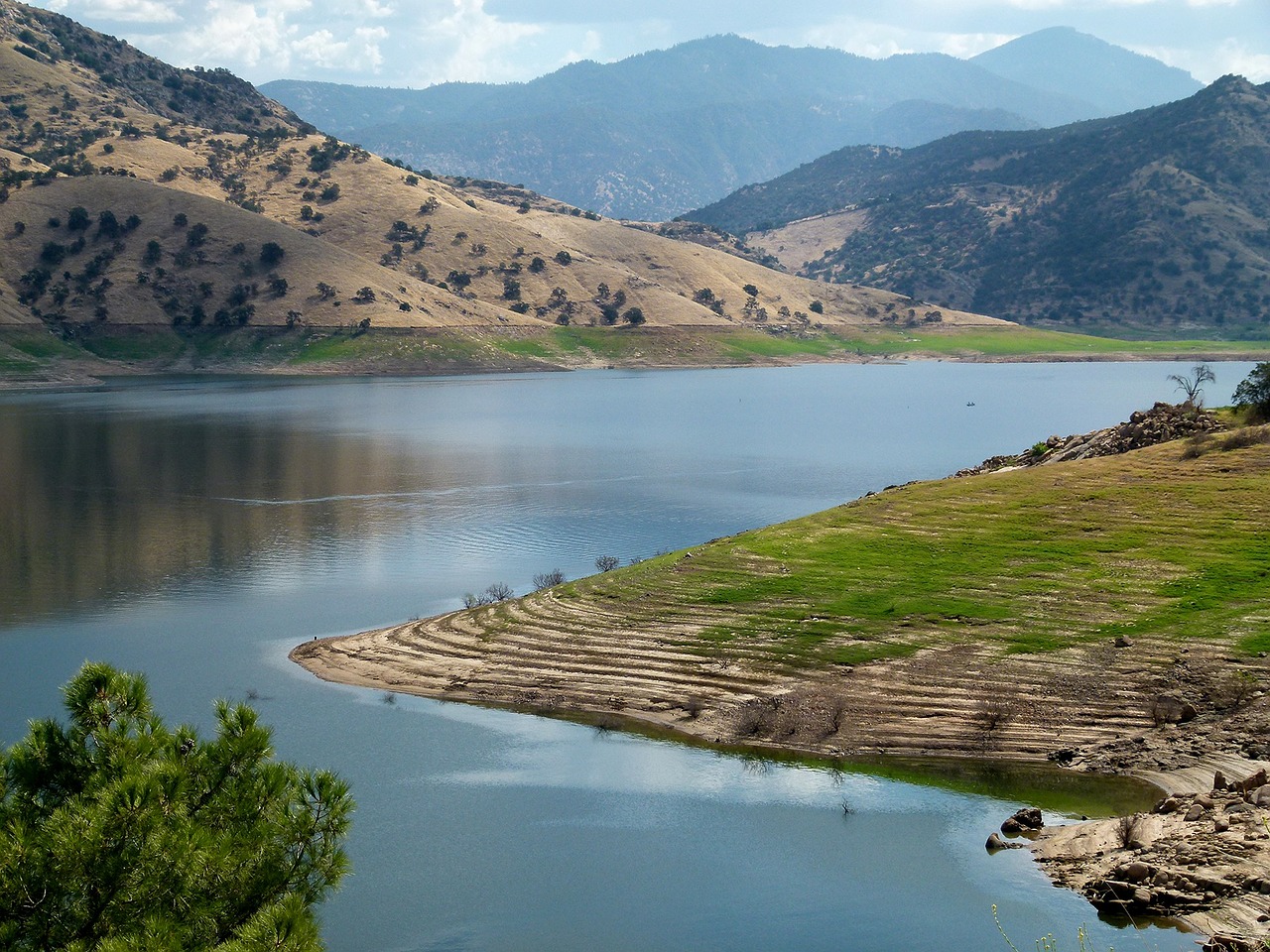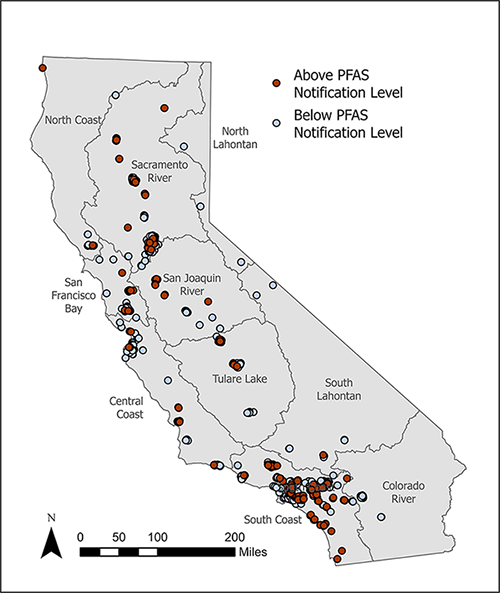By Walker Grimshaw
Stressors to sustainable water management in California
Water providers in California face myriad challenges in sustainably providing high quality drinking water to their customers while protecting the natural environment.

While agencies may have little direct impact on these external stressors, they have choices in how to respond and adapt to such stress to successfully supply high quality and affordable water to communities.
In this blog post, I explore the stress that surface water and groundwater quality challenges pose for California’s retail water agencies.
Groundwater quality stresses small water systems
More than 80% of Californians rely on groundwater for at least part of their drinking water. Groundwater aquifers also serve as a natural storage and treatment system for water and are vital to providing clean water throughout the arid American West.
“More than 80% of Californians rely on groundwater for at least part of their drinking water.”
However, when contaminated, water managers must treat groundwater; mix it with other, higher-quality water sources; or drill new wells to access new sources entirely. Each of these approaches increases the complexity of the water system, and the extra costs can increase the price of water for customers. Complex water systems and increased costs are especially large challenges for small water systems with limited technical capacity and a smaller customer base. For these small water systems, the cost of infrastructure and training for operations and maintenance staff is spread among fewer customers.
Both large and small water systems must test the quality of their raw water throughout the year. Municipal groundwater data from 2019 show that across California, large water systems are more likely to pump contaminated groundwater than small water systems. However, despite the increased likelihood of pumping contaminated groundwater, these large systems are not more likely nationally to violate drinking water standards. The reason? Large systems have a greater capacity to treat the contaminated groundwater to meet EPA and state drinking water standards.
Assessing and Addressing Contaminated Groundwater
The quality of raw groundwater is measured relative to comparison concentrations, above which there are increased negative impacts to human health or environmental health.
Comparison concentrations include Maximum Contaminant Levels (MCLs), health-based action levels, and notification levels, among others, and each type of comparison concentration has different regulatory consequences and implications for human health. For example, drinking water contaminant concentrations cannot legally exceed federal MCLs under the Safe Drinking Water Act. Water systems with MCL violations must find ways to improve their water quality through new water sources or more treatment.
On the other hand, contaminants exceeding notification levels, as their name implies, only require notification of customers and local government. They do not require treatment or removal from the water.
PFAS are unregulated and occur in groundwater across California
While many contaminants are regulated through the Safe Drinking Water Act, additional chemicals are increasingly being monitored and regulated as they are discovered in the environment. One category of these chemicals, PFAS (per- and polyfluoroalkyl substances), are man-made chemicals used to produce heat– and water-resistant materials, often referred to as “forever chemicals.” They have recently gained public attention for their negative health effects, presence in water resources, and persistence in the environment. PFAS are currently monitored, but they are not regulated at the state or federal level. Instead, they only have notification levels, requiring notification of local governing bodies (i.e. city or county) when their presence exceeds their respective notification level.
Two chemicals in the PFAS family, PFOS and PFOA, are monitored widely across California, and in 2019, nearly one third of all PFOS/PFOA observations in raw groundwater were above a notification level. Measurements exceeding the notification level occur throughout the state and are not limited to any one geographic area.
“Two chemicals in the PFAS family, PFOS and PFOA, are monitored widely across the state, and in 2019, nearly one third of all PFOS/PFOA observations in raw groundwater were above a notification level.”
As research on the human impacts of PFAS continue, the EPA or CalEPA could introduce an MCL to supplement the existing notification level. If so, many water systems would need to install treatment to specifically remove these forever chemicals, representing a large potential stressor for retail water systems. The Orange County Water District has already begun the nation’s largest PFAS Pilot Program to identify the best treatment methods for their water.
Surface Water Quality
Surface water supplies typically require more treatment than groundwater to achieve high quality drinking water, and small changes in surface water quality can have large impacts on entire ecosystems. As with groundwater, surface water quality directly impacts the price of safe, treated water for consumers or the need to explore other, higher quality sources of water.
Impaired Surface Waters and TMDLs
The EPA tracks surface water quality nationally in a compiled list of impaired waters, called the 303(d) listings. Section 303(d) of the Clean Water Act charges states and tribes to assess the quality of the surface water bodies within their boundaries.
Every two years, each state must assess their water bodies using all available water quality-related data. Each assessed water body is designated as impaired, threatened, or good based on the ability of the water to meet water quality standards for its intended beneficial uses. Beneficial uses may include drinking water supply, recreation, aquatic life support, and fish consumption, among others, and they determine the acceptable water quality of water bodies.
For waters designated as impaired, the state must then develop Total Maximum Daily Loads (TMDLs) for the pollutants in that water body. The goal is to determine the maximum amount of pollution that can enter the water body and still meet water quality standards. The TMDL then serves as the basis for regulating sources of pollution to that body of water.
Pesticides and Nutrients
The most common pollutants in California’s surface waters are pesticides, nutrients, metals, and fecal indicator bacteria. However, unlike the ubiquity of PFAS in groundwater across the state, pesticides appear mostly in the Central Valley, Central Coast, and Imperial Valley while nutrient contamination is worse in the Klamath River basin, the Pajaro, and the Aliso-San Onofre.
The maps below show the distribution of pesticide– and nutrient–contaminated waters in the watersheds of California. As not all watersheds have the same number of streams and not all streams are assessed for impairment, the number of impairments for pesticides and nutrients are divided by the total number of assessed streams in each watershed.

Much of the groundwater and surface water in California is contaminated, some naturally occurring and some because of human action. Contaminants harm environmental systems and pose a threat to human health. Monitoring is key to understanding the location and severity of contamination and allows regulators and the public to prioritize efforts at water quality improvement.
How to learn more about your drinking water quality
Despite widespread water pollution, drinking water across California is largely safe, as contaminated source water does not necessarily lead to contaminated drinking water. Instead, it provides a greater challenge to providing safe drinking water, and treatment can increase the cost of the water. If you are interested in learning about the quality of your tap water, you can look up your water provider through Drinking Water Watch.



